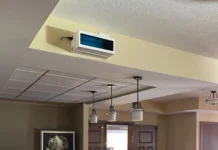By Lianfeng Zhang, Laboratory of Ecology and Environmental Protection, Research Institute of Tsinghua University in Shenzhen
The IUVA protocol (Lawal et al., 2008, 2017) for lamp measurement has been in use for 15 years, gaining significant global recognition and acceptance. Fifteen years of practical application have validated its capability to produce consistently reproducible measurements and results. To maximize the protocol’s potential, the author would like to share some technical insights on several crucial issues.
Measurement Distance
The protocol specifies a distance range of L/2-4L (where L represents the lamp’s arc length).
- The protocol mandates placing the probe within the range of L/2-4L. For instance, with a 2.5-meter-long lamp, the probe can be positioned at 10 meters (4L) or at 1.25 meters (L/2), depending on the laboratory’s practical limitations.
- To characterize the UV output accurately, measurements should be taken at various distances within the range of L/2-4L to validate the consistency of the measured UV outputs at various distances, ensuring quality control and accuracy.
Selection of UV Radiometer
The protocol has defined the UV radiometer properties, which must be strictly adhered to.
Safety
The initial version of the protocol (Lawal et al., 2008) had an entirely open measurement system, while the revised version (Lawal et al., 2017) introduced a “removable mask” or “slotted divider” for minimizing the effects of reflected UV, which actually improved the safety circumstance. Although safety concerns did not impede the IUVA protocol’s implementation, ensuring safety remains a serious consideration.
Extension for Underwater Lamp Measurements
The protocol for the lamp is in an open-air environment. To measure underwater lamps:
- Direct application of UV-radiometer readings in the Keitz equation is not correct. However, a proposed solution (Zhang et al., 2021) addresses this issue.
- Considering the potential formation of bubbles due to temperature differences between the water and lamp/sleeve surface, the theoretical foundation for such occurrences is indeterminate from a physics standpoint. Even if micro-bubbles form on the sleeve, their presence in both industrial and laboratory conditions implies the truth of measured data in the laboratory setting.
These refinements and considerations will solidify further the IUVA protocol’s efficacy and applicability across various settings, ensuring accurate and reliable measurements.
Resources
Lawal O, Dussert B, Craig H, et al. Proposed method for measurement of the output of monochromatic (254 nm) low-pressure UV lamps. IUVA News, 2008, 10(1): 14-17.
Lawal O, Dussert B, Craig H, et al. Method for the measurement of the output of monochromatic (254 nm) low-pressure UV lamps. IUVA News, 2017, 19(1): 9-16.
Zhang L, Song Y, Zhang J, Tong Z. Measurement of the UV Output of an Underwater Monochromatic (254 nm) Low-Pressure-Mercury UV lamp. J. Environ. Eng. 2021, 147(4): 0402006






